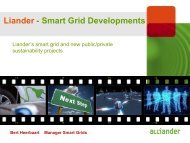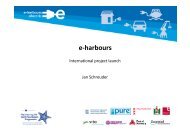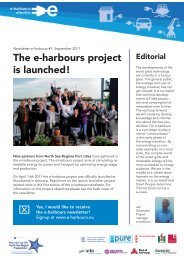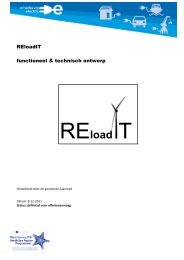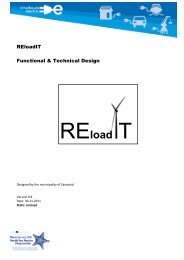renewable energy in zaanstad: from theory to practice - e-harbours
renewable energy in zaanstad: from theory to practice - e-harbours
renewable energy in zaanstad: from theory to practice - e-harbours
Create successful ePaper yourself
Turn your PDF publications into a flip-book with our unique Google optimized e-Paper software.
5.4 TECHNICAL SPECIFICATIONS<br />
In chapter 4 the concept of Smart Grid has been reviewed with the def<strong>in</strong>itions and capabilities given<br />
<strong>in</strong> the literature. Smart Grid is a very broad concept with a lot of different possibilities and objectives.<br />
An objective can for <strong>in</strong>stance be f<strong>in</strong>ancial optimization with<strong>in</strong> a cluster of distributed genera<strong>to</strong>rs and<br />
<strong>energy</strong> consumers. In that case it can be characterized as a Virtual Power Plant. Whatever objective it<br />
is; a possible way of achiev<strong>in</strong>g a particular objective is the usage of a Multi-Agent System (MAS)<br />
technology. A MAS technology provides a way <strong>to</strong> implement complex distributed, scalable and open<br />
ICT system [18]. It consists of several software agents – device agents – which carry out programmed<br />
tasks called bus<strong>in</strong>ess rules device agents each calculate its own priority; i.e. the priority <strong>to</strong> supply or<br />
consume <strong>energy</strong>.<br />
In the REloadIT project the objective is <strong>to</strong> optimize the production of <strong>renewable</strong> <strong>energy</strong> for the<br />
charg<strong>in</strong>g of the electric vehicles. In this particular case the device agents consist of distributed<br />
genera<strong>to</strong>rs, the charg<strong>in</strong>g devices of the electric vehicles and a bus<strong>in</strong>ess agent for the weather<br />
forecast. The priority of all the agents is send <strong>to</strong> the priority manager, which analyzes the priorities<br />
of the agents and optimizes the bus<strong>in</strong>ess case.<br />
Figure 17. Technical design of the MAS system used <strong>in</strong> the REloadIT project [20]<br />
The bus<strong>in</strong>ess rules <strong>in</strong> the REloadIT project are [20]:<br />
� Optimiz<strong>in</strong>g the usage of the production of the PV cells (and future w<strong>in</strong>d turb<strong>in</strong>es) for the<br />
consumption of the electric vehicles<br />
� Guarantee<strong>in</strong>g the state of charge of the electric vehicles<br />
� F<strong>in</strong>ancial optimization of electricity underproduction; i.e. buy<strong>in</strong>g at off peak hours and<br />
operat<strong>in</strong>g <strong>energy</strong> <strong>in</strong>tensive devices.<br />
28



